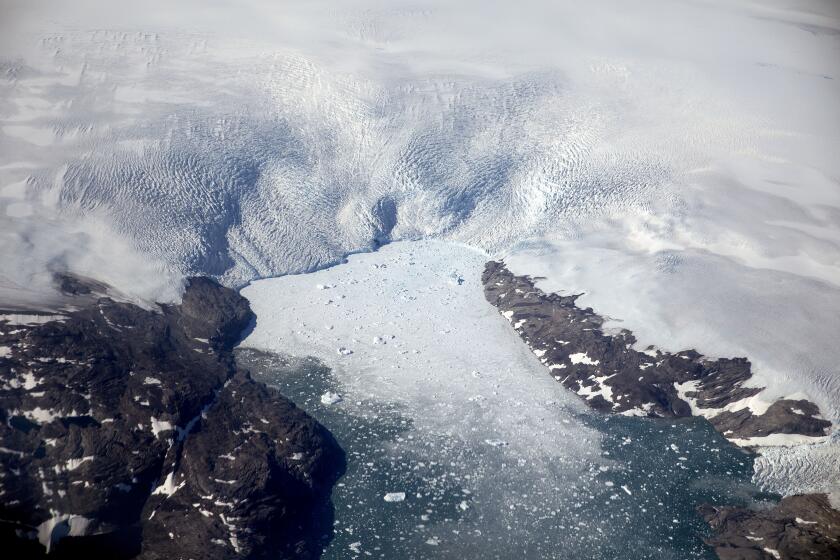
Humanity is ignoring major planetary vital signs as atmospheric carbon dioxide levels soar to all-time highs and Earth records its 12th consecutive month of record-breaking heat, international climate officials warned this week.
At 60.63 degrees, the global mean temperature in May was a record 2.73 degrees hotter than the preindustrial average against which warming is measured — marking an astonishing yearlong streak of heat that shows little sign of slowing down, according to the European Union’s Copernicus Climate Change Service.
“For the past year, every turn of the calendar has turned up the heat,” António Guterres, secretary-general of the United Nations, said during a speech in New York on Wednesday. “Our planet is trying to tell us something. But we don’t seem to be listening. We’re shattering global temperature records and reaping the whirlwind. It’s climate crunch time. Now is the time to mobilize, act and deliver.”
Aggressive and impactful reporting on climate change, the environment, health and science.
According to the Copernicus service, May was also the 11th consecutive month of warming beyond 2.7 degrees, the Fahrenheit equivalent of the internationally agreed-upon limit of 1.5 degrees Celsius intended to reduce the worst effects of climate change.
Not only was it a warm month, but the global average temperature for the last 12 months — June 2023 through May — was the highest on record, at 2.93 degrees Fahrenheit above the 1850-1900 preindustrial average.

Guterres said the world is warming so quickly and spewing such considerable CO₂ emissions that the 1.5-degree Celsius goal is “hanging by a thread.”
“The truth is, global emissions need to fall 9% every year until 2030 to keep the 1.5-degree limit alive, but they are heading in the wrong direction,” he told a crowd at the American Museum of Natural History. “We are playing Russian roulette with our planet, and we need an exit ramp off the highway to climate hell.”
Extreme heat is becoming more frequent and more severe. Here’s how much hotter it could get in California and the West.
Indeed, it’s not just global temperatures that are soaring. Carbon dioxide levels — one of the main drivers of planetary warming — are also climbing to new highs.
Recent readings were 427 parts per million — the highest ever recorded in the month of May, according to Ralph Keeling, director of the CO₂ program at UC San Diego’s Scripps Institution of Oceanography.
Carbon dioxide does not directly provide heat, but the greenhouse gas — which comes from the extraction and burning of fossil fuels — increases the atmosphere’s ability to trap heat that otherwise would be released to space.
CO₂ readings have been primarily measured at the Mauna Loa Observatory in Hawaii since 1958, when they began under Keeling’s father, Charles David Keeling. The graph of accumulating CO₂ levels, known as the Keeling Curve, has been steadily climbing since then.
But the planet isn’t only seeing record CO₂ levels — it is also seeing record gains, Keeling said.
The monthly average CO₂ concentration recorded in March was 4.7 parts per million higher than the reading from March 2023 — breaking the previous record for year-over-year gain, a jump of 4.1 parts per million from June 2015 to June 2016.
“That number was sticking out of the envelope of what we’ve seen in the past,” Keeling said.
Fossil fuels play the biggest role in the recent record numbers, but El Niño also had a hand, he said.
The tropical Pacific climate pattern that arrived last summer is associated with hotter global temperatures, as well as droughts in the tropics and some southern continents. As a result, tropical forests, savannas and grasslands in those areas tend to wither and die and burn in wildfires, contributing to additional CO₂ emissions.

“We have the highest fossil fuel burning, but we also had an El Niño event, and so the combination set a new all-time record,” Keeling said.
When asked how it feels to see the chart that bears his father’s name climb so steadily, Keeling said he mostly feels sad. Though there have been considerable gains in renewable energy and other efforts to reduce fossil fuel emissions, “we haven’t gained enough ground yet to reverse the growth,” he said.
“I just feel sad at all the loss that has been occurring, and will continue to occur, because of this,” he said.
A powerful high-pressure ridge will bring unusually hot temperatures to the Golden State by the middle of this week, before spreading into the Pacific Northwest.
During his speech Wednesday, Guterres said new data show the maximum amount of CO₂ the Earth’s atmosphere can take in order to limit long-term warming to 1.5 degrees Celsius is about 200 billion tons. But current emissions are around 40 billion tons per year, indicating that “the entire carbon budget will be busted before 2030.”
The 1.5-degree limit is not just symbolic — every fraction of a degree could mean the difference between extinction and survival for some small island states and coastal communities, or the difference between minimizing climate chaos and crossing dangerous tipping points, Guterres said.
Consequences of higher global temperatures include the likely collapse of the Greenland and West Antarctic ice sheets and associated sea level rise; the destruction of coral reef systems; the loss of livelihoods for hundreds of millions of people; the collapse of sea currents that would disrupt weather patterns in Europe and other parts of the world; and widespread permafrost melt that would release more heat-trapping methane, among other outcomes, Guterres said.
He said urgent action and global cooperation are needed, and the 2020s will be the make-or-break decade. Cities, states and national governments must all play their part — as must fossil fuel corporations and global financial institutions — with actionable transition plans in place no later than the 2025 U.N. climate conference in Brazil, he said.
“It’s a transformation of society, and it’s a transformation of policy, and it is a real redesign of the priorities that we see in today’s world,” Guterres said. “Unfortunately, climate change has been victim of a diversion of attention, of public opinions, of governments and of media because of the horrible conflicts we are witnessing. ... We cannot let them distract us from what is the existential threat of our times for humankind, and that is climate change.”
New research warns of a possible collapse in Atlantic Ocean currents due to climate change. That could fundamentally alter global weather patterns.
The latest broken records come as the western United States braces for a significant heat wave beginning this week that could see temperatures soar into the triple digits in many areas.
Portions of California and the Pacific Northwest are expected to see high temperatures well above average for the time of year, forecasters said — as hot as 110 degrees in the San Joaquin and Sacramento valleys, and more than 100 degrees near the northernmost part of the state.
The heat wave is expected to set the stage for a long, hot summer across the vast majority of the country, according to the latest seasonal temperature outlook from the National Oceanic and Atmospheric Administration, which shows strong odds for warmer-than-normal conditions in almost every state.
Copernicus’ director, Carl Buontempo, said the ongoing global heat streak is “shocking but not surprising.”
“While this sequence of record-breaking months will eventually be interrupted, the overall signature of climate change remains and there is no sign in sight of a change in such a trend,” he said in a statement.
“We are living in unprecedented times, but we also have unprecedented skill in monitoring the climate, and this can help inform our action,” Buontempo said. “This string of hottest months will be remembered as comparatively cold but if we manage to stabilize the concentrations of [greenhouse gases] in the atmosphere in the very near future we might be able to return to these ‘cold’ temperatures by the end of the century.”
With five months of data already in the books, there is now a roughly 75% chance that 2024 will surpass 2023 as the planet’s hottest year on record, Zeke Hausfather, a climate scientist with Berkeley Earth, said in a post on the social media site X.
As the records keep tumbling, Hausfather said, it is also looking likely that June will be the hottest June on record as well.
Toward a more sustainable California
Get Boiling Point, our newsletter exploring climate change, energy and the environment, and become part of the conversation — and the solution.
You may occasionally receive promotional content from the Los Angeles Times.











